Effects of Emission Variability on Atmospheric CO2 Concentrations in Mainland China
Abstract
1. Introduction
2. Materials and Methods
2.1. Model Description
2.2. Emissions
2.2.1. ODIAC
2.2.2. MEIC
2.2.3. EDGAR
2.3. Satellite Observations
2.4. Ground-Based CO2 Observations
3. Results and Discussion
3.1. Spatiotemporal Distribution of Emissions and Simulated XCO2
3.2. Comparisons with Satellite XCO2
3.3. Validation with Ground-Based Observations
3.4. The Impact of Emission Variability on XCO2
4. Conclusions
Author Contributions
Funding
Data Availability Statement
Acknowledgments
Conflicts of Interest
Appendix A


| 2018 | 2019 | 2020 | |
|---|---|---|---|
| Fossil CO2 emissions | 10 + 0.5 | 9.7 ± 0.5 | 9.3 ± 0.5 |
| Land-use change emissions | 1.5 ± 0.7 | 1.8 ± 0.7 | 0.9 ± 0.7 |
| Total emissions | 11.5 ± 0.9 | 11.5 ± 0.9 | 10.2 ± 0.8 |
| Partitioning | |||
| Ocean sink | 2.6 ± 0.6 | 2.6 ± 0.6 | 3.0 ± 0.4 |
| Terrestrial sink | 3.5 ± 0.7 | 3.1 ± 1.2 | 2.9 ± 1.0 |
| Annual CO2 fluxes | 5.4 | 5.8 | 4.3 |
| Reference | [71] | [72] | [73] |
| Flux Type | Inventory Name/Abbreviation | 2018 | 2019 | 2020 | Reference |
|---|---|---|---|---|---|
| Fossil fuel and cement manufacture | ODIAC | 10.11 | 10.17 | 9.7 | [49] |
| EDGAR | 10.34 | 10.36 | 9.82 | [10,74,75,76] | |
| Biomass burning | GFEDv4.1s | 1.67 | 2.06 | 1.81 | [41] |
| Balanced biosphere | SiB3 | 0 | 0 | 0 | [43] |
| Residual annual terrestrial exchange | TransCom climatology (fixed in 2006) | −5.29 | −5.29 | −5.29 | [44] |
| Ocean exchange | Scaled ocean exchange (fixed in 2009) | −1.41 | −1.41 | −1.41 | [42] |
| Shipping | CEDS | 0.236 | 0.23 | 0.23 | [45,77] |
| Aviation | AEIC | 0.16 | 0.16 | 0.16 | [37,47] |
| Chemical source | GEOS-Chem CO2 Chemical Source | 1.04–1.06 | 1.04–1.06 | 1.04–1.06 | [37] |
| Total CO2 flux (chemical source not included) | Using ODIAC as FF flux | 5.476 | 5.92 | 5.2 | |
| Using EDGAR as FF flux | 5.706 | 6.11 | 5.32 |
References
- Lan, X.; Tans, P.; Thoning, K.W. Trends in Globally-Averaged CO2 Determined from NOAA Global Monitoring Laboratory Measurements. Available online: https://gml.noaa.gov/ccgg/trends/gl_data.html (accessed on 1 December 2024).
- Manabe, S.; Wetherald, R.T. Thermal Equilibrium of the Atmosphere with a Given Distribution of Relative Humidity. J. Atmos. Sci. 1967, 24, 241–259. [Google Scholar] [CrossRef]
- Gunter, W.D.; Wong, S.; Cheel, D.B.; Sjostrom, G. Large CO2 Sinks: Their role in the mitigation of greenhouse gases from an international, national (Canadian) and provincial (Alberta) perspective. Appl. Energy 1998, 61, 209–227. [Google Scholar] [CrossRef]
- IPCC. Climate Change 2021: The Physical Science Basis. Contribution of Working Group I to the Sixth Assessment Report of the Intergovernmental Panel on Climate Change; Cambridge University Press: Cambridge, UK, 2021. [Google Scholar]
- Friedlingstein, P.; O’Sullivan, M.; Jones, M.W.; Andrew, R.M.; Bakker, D.C.E.; Hauck, J.; Landschützer, P.; Le Quéré, C.; Luijkx, I.T.; Peters, G.P.; et al. Global Carbon Budget 2023. Earth Syst. Sci. Data 2023, 15, 5301–5369. [Google Scholar] [CrossRef]
- Schimel, D. Carbon cycle conundrums. Proc. Natl. Acad. Sci. USA 2007, 104, 18353–18354. [Google Scholar] [CrossRef]
- Kou, X.; Zhang, M.; Peng, Z.; Wang, Y. Assessment of the biospheric contribution to surface atmospheric CO2 concentrations over East Asia with a regional chemical transport model. Adv. Atmos. Sci. 2015, 32, 287–300. [Google Scholar] [CrossRef]
- Fu, Y.; Liao, H.; Tian, X.; Gao, H.; Jia, B.; Han, R. Impact of Prior Terrestrial Carbon Fluxes on Simulations of Atmospheric CO2 Concentrations. J. Geophys. Res. Atmos. 2021, 126, e2021JD034794. [Google Scholar] [CrossRef]
- Andres, R.J.; Boden, T.A.; Higdon, D. A new evaluation of the uncertainty associated with CDIAC estimates of fossil fuel carbon dioxide emission. Tellus B Chem. Phys. Meteorol. 2014, 66, 23616. [Google Scholar] [CrossRef]
- Crippa, M.; Guizzardi, D.; Banja, M.; Solazzo, E.; Muntean, M.; Schaaf, E.; Pagani, F.; Monforti, F.; Olivier, J.; Quadrelli, R.; et al. CO2 Emissions of All World Countries; JRC/IEA/PBL 2022 Report; Publications Office of the European Union: Luxembourg, 2022. [Google Scholar]
- Solazzo, E.; Crippa, M.; Guizzardi, D.; Muntean, M.; Choulga, M.; Janssens-Maenhout, G. Uncertainties in the Emissions Database for Global Atmospheric Research (EDGAR) emission inventory of greenhouse gases. Atmos. Chem. Phys. 2021, 21, 5655–5683. [Google Scholar] [CrossRef]
- Marland, G. China’s uncertain CO2 emissions. Nat. Clim. Change 2012, 2, 645–646. [Google Scholar] [CrossRef]
- Gregg, J.S.; Andres, R.J.; Marland, G. China: Emissions pattern of the world leader in CO2 emissions from fossil fuel consumption and cement production. Geophys. Res. Lett. 2008, 35, L08806. [Google Scholar] [CrossRef]
- Andres, R.J.; Boden, T.A.; Bréon, F.M.; Ciais, P.; Davis, S.; Erickson, D.; Gregg, J.S.; Jacobson, A.; Marland, G.; Miller, J.; et al. A synthesis of carbon dioxide emissions from fossil-fuel combustion. Biogeosciences 2012, 9, 1845–1871. [Google Scholar] [CrossRef]
- Liu, Z.; Deng, Z.; He, G.; Wang, H.; Zhang, X.; Lin, J.; Qi, Y.; Liang, X. Challenges and opportunities for carbon neutrality in China. Nat. Rev. Earth Environ. 2021, 3, 141–155. [Google Scholar] [CrossRef]
- Shan, Y.; Guan, D.; Zheng, H.; Ou, J.; Li, Y.; Meng, J.; Mi, Z.; Liu, Z.; Zhang, Q. China CO2 emission accounts 1997–2015. Sci. Data 2018, 5, 170201. [Google Scholar] [CrossRef]
- Guan, D.; Liu, Z.; Geng, Y.; Lindner, S.; Klaus, H. The gigatonne gap in China’s carbon dioxide inventories. Nat. Clim. Change 2012, 2, 672–675. [Google Scholar] [CrossRef]
- Liu, Z.; Guan, D.; Wei, W.; Davis, S.J.; Ciais, P.; Bai, J.; Peng, S.; Zhang, Q.; Hubacek, K.; Marland, G.; et al. Reduced carbon emission estimates from fossil fuel combustion and cement production in China. Nature 2015, 524, 335–338. [Google Scholar] [CrossRef]
- Nassar, R.; Napier-Linton, L.; Gurney, K.R.; Andres, R.J.; Oda, T.; Vogel, F.R.; Deng, F. Improving the temporal and spatial distribution of CO2 emissions from global fossil fuel emission data sets. J. Geophys. Res. Atmos. 2013, 118, 917–933. [Google Scholar] [CrossRef]
- Gurney, K.R.; Law, R.M.; Denning, A.S.; Rayner, P.J.; Baker, D.; Bousquet, P.; Bruhwiler, L.; Chen, Y.-H.; Ciais, P.; Fan, S.; et al. TransCom 3 CO2 inversion intercomparison: 1. Annual mean control results and sensitivity to transport and prior flux information. Tellus B 2003, 55, 555–579. [Google Scholar] [CrossRef]
- O’Dell, C.W.; Eldering, A.; Wennberg, P.O.; Crisp, D.; Gunson, M.R.; Fisher, B.; Frankenberg, C.; Kiel, M.; Lindqvist, H.; Mandrake, L.; et al. Improved retrievals of carbon dioxide from Orbiting Carbon Observatory-2 with the version 8 ACOS algorithm. Atmos. Meas. Tech. 2018, 11, 6539–6576. [Google Scholar] [CrossRef]
- Yokota, T.; Yoshida, Y.; Eguchi, N.; Ota, Y.; Tanaka, T.; Watanabe, H.; Maksyutov, S. Global Concentrations of CO2 and CH4 Retrieved from GOSAT: First Preliminary Results. SOLA 2009, 5, 160–163. [Google Scholar] [CrossRef]
- Liu, Y.; Wang, J.; Yao, L.; Chen, X.; Cai, Z.; Yang, D.; Yin, Z.; Gu, S.; Tian, L.; Lu, N.; et al. The TanSat mission: Preliminary global observations. Sci. Bull. 2018, 63, 1200–1207. [Google Scholar] [CrossRef] [PubMed]
- Wunch, D.; Toon, G.C.; Blavier, J.-F.L.; Washenfelder, R.A.; Notholt, J.; Connor, B.J.; Griffith, D.W.T.; Sherlock, V.; Wennberg, P.O. The Total Carbon Column Observing Network. Philos. Trans. R. Soc. A Math. Phys. Eng. Sci. 2011, 369, 2087–2112. [Google Scholar] [CrossRef]
- Frey, M.; Sha, M.K.; Hase, F.; Kiel, M.; Blumenstock, T.; Harig, R.; Surawicz, G.; Deutscher, N.M.; Shiomi, K.; Franklin, J.E.; et al. Building the COllaborative Carbon Column Observing Network (COCCON): Long-term stability and ensemble performance of the EM27/SUN Fourier transform spectrometer. Atmos. Meas. Tech. 2019, 12, 1513–1530. [Google Scholar] [CrossRef]
- Jing, Y.; Shi, J.; Wang, T. Evaluation and comparison of atmospheric CO2 concentrations from models and satellite retrievals. In Proceedings of the 2015 IEEE International Geoscience and Remote Sensing Symposium (IGARSS), Milan, Italy, 26–31 July 2015; pp. 2202–2205. [Google Scholar]
- Zhang, H.; Chen, B.; Xu, G.; Yan, J.; Che, M.; Chen, J.; Fang, S.; Lin, X.; Sun, S. Comparing simulated atmospheric carbon dioxide concentration with GOSAT retrievals. Sci. Bull. 2015, 60, 380–386. [Google Scholar] [CrossRef]
- Lei, L.; Guan, X.; Zeng, Z.; Zhang, B.; Ru, F.; Bu, R. A comparison of atmospheric CO2 concentration GOSAT-based observations and model simulations. Sci. China Earth Sci. 2014, 57, 1393–1402. [Google Scholar] [CrossRef]
- Li, R.; Zhang, M.; Chen, L.; Kou, X.; Skorokhod, A. CMAQ simulation of atmospheric CO2 concentration in East Asia: Comparison with GOSAT observations and ground measurements. Atmos. Environ. 2017, 160, 176–185. [Google Scholar] [CrossRef]
- Ma, X.-Y.; Huang, W.-J.; Hu, N.; Xiao, W.; Hu, C.; Zhang, M.; Cao, C.; Zhao, J.-Y. Simulation of Anthropogenic CO2 Emissions in the Yangtze River Delta Based on Different Emission Inventories. Environ. Sci. 2023, 44, 2009–2021. [Google Scholar] [CrossRef]
- Zhang, S.; Tian, X. The impacts of modeling global CO2 concentrations with GEOS-Chem using different ocean carbon fluxes. Atmos. Ocean. Sci. Lett. 2019, 12, 343–348. [Google Scholar] [CrossRef]
- Su, M.; Shi, Y.; Yang, Y.; Guo, W. Impacts of different biomass burning emission inventories: Simulations of atmospheric CO2 concentrations based on GEOS-Chem. Sci. Total Environ. 2023, 876, 162825. [Google Scholar] [CrossRef] [PubMed]
- Ciais, P.; Rayner, P.; Chevallier, F.; Bousquet, P.; Logan, M.; Peylin, P.; Ramonet, M. Atmospheric inversions for estimating CO2 fluxes: Methods and perspectives. Clim. Change 2010, 103, 69–92. [Google Scholar] [CrossRef]
- Yang, D.; Liu, Y.; Feng, L.; Wang, J.; Yao, L.; Cai, Z.; Zhu, S.; Lu, N.; Lyu, D. The First Global Carbon Dioxide Flux Map Derived from TanSat Measurements. Adv. Atmos. Sci. 2021, 38, 1433–1443. [Google Scholar] [CrossRef]
- Kong, Y.; Zheng, B.; Zhang, Q.; He, K. Global and regional carbon budget for 2015–2020 inferred from OCO-2 based on an ensemble Kalman filter coupled with GEOS-Chem. Atmos. Chem. Phys. 2022, 22, 10769–10788. [Google Scholar] [CrossRef]
- Suntharalingam, P.; Jacob, D.J.; Palmer, P.I.; Logan, J.A.; Yantosca, R.M.; Xiao, Y.; Evans, M.J.; Streets, D.G.; Vay, S.L.; Sachse, G.W. Improved quantification of Chinese carbon fluxes using CO2/CO correlations in Asian outflow. J. Geophys. Res. Atmos. 2004, 109, D18S18. [Google Scholar] [CrossRef]
- Nassar, R.; Jones, D.B.A.; Suntharalingam, P.; Chen, J.M.; Andres, R.J.; Wecht, K.J.; Yantosca, R.M.; Kulawik, S.S.; Bowman, K.W.; Worden, J.R.; et al. Modeling global atmospheric CO2 with improved emission inventories and CO2 production from the oxidation of other carbon species. Geosci. Model Dev. 2010, 3, 689–716. [Google Scholar] [CrossRef]
- Oda, T.; Maksyutov, S. A very high-resolution (1 km × 1 km) global fossil fuel CO2 emission inventory derived using a point source database and satellite observations of nighttime lights. Atmos. Chem. Phys. 2011, 11, 543–556. [Google Scholar] [CrossRef]
- Zheng, B.; Tong, D.; Li, M.; Liu, F.; Hong, C.; Geng, G.; Li, H.; Li, X.; Peng, L.; Qi, J.; et al. Trends in China’s anthropogenic emissions since 2010 as the consequence of clean air actions. Atmos. Chem. Phys. 2018, 18, 14095–14111. [Google Scholar] [CrossRef]
- Li, M.; Liu, H.; Geng, G.; Hong, C.; Liu, F.; Song, Y.; Tong, D.; Zheng, B.; Cui, H.; Man, H.; et al. Anthropogenic emission inventories in China: A review. Natl. Sci. Rev. 2017, 4, 834–866. [Google Scholar] [CrossRef]
- van der Werf, G.R.; Randerson, J.T.; Giglio, L.; van Leeuwen, T.T.; Chen, Y.; Rogers, B.M.; Mu, M.; van Marle, M.J.E.; Morton, D.C.; Collatz, G.J.; et al. Global fire emissions estimates during 1997–2016. Earth Syst. Sci. Data 2017, 9, 697–720. [Google Scholar] [CrossRef]
- Takahashi, T.; Sutherland, S.C.; Wanninkhof, R.; Sweeney, C.; Feely, R.A.; Chipman, D.W.; Hales, B.; Friederich, G.; Chavez, F.; Sabine, C.; et al. Climatological mean and decadal change in surface ocean pCO2, and net sea–air CO2 flux over the global oceans. Deep. Sea Res. Part II Top. Stud. Oceanogr. 2009, 56, 554–577. [Google Scholar] [CrossRef]
- Messerschmidt, J.; Parazoo, N.; Wunch, D.; Deutscher, N.M.; Roehl, C.; Warneke, T.; Wennberg, P.O. Evaluation of seasonal atmosphere–biosphere exchange estimations with TCCON measurements. Atmos. Chem. Phys. 2013, 13, 5103–5115. [Google Scholar] [CrossRef]
- Baker, D.F.; Law, R.M.; Gurney, K.R.; Rayner, P.; Peylin, P.; Denning, A.S.; Bousquet, P.; Bruhwiler, L.; Chen, Y.H.; Ciais, P.; et al. TransCom 3 inversion intercomparison: Impact of transport model errors on the interannual variability of regional CO2 fluxes, 1988–2003. Glob. Biogeochem. Cycles 2006, 20, GB1002. [Google Scholar] [CrossRef]
- Hoesly, R.M.; Smith, S.J.; Feng, L.; Klimont, Z.; Janssens-Maenhout, G.; Pitkanen, T.; Seibert, J.J.; Vu, L.; Andres, R.J.; Bolt, R.M.; et al. Historical (1750–2014) anthropogenic emissions of reactive gases and aerosols from the Community Emissions Data System (CEDS). Geosci. Model Dev. 2018, 11, 369–408. [Google Scholar] [CrossRef]
- Simone, N.W.; Stettler, M.E.J.; Barrett, S.R.H. Rapid estimation of global civil aviation emissions with uncertainty quantification. Transp. Res. Part D Transp. Environ. 2013, 25, 33–41. [Google Scholar] [CrossRef]
- Olsen, S.C.; Brasseur, G.P.; Wuebbles, D.J.; Barrett, S.R.H.; Dang, H.; Eastham, S.D.; Jacobson, M.Z.; Khodayari, A.; Selkirk, H.; Sokolov, A.; et al. Comparison of model estimates of the effects of aviation emissions on atmospheric ozone and methane. Geophys. Res. Lett. 2013, 40, 6004–6009. [Google Scholar] [CrossRef]
- Reddington, C.L.; Conibear, L.; Robinson, S.; Knote, C.; Arnold, S.R.; Spracklen, D.V. Air Pollution from Forest and Vegetation Fires in Southeast Asia Disproportionately Impacts the Poor. GeoHealth 2021, 5, e2021GH000418. [Google Scholar] [CrossRef] [PubMed]
- Oda, T.; Maksyutov, S. ODIAC Fossil Fuel CO2 Emissions Dataset (Version Name: ODIAC2022); Center for Global Environmental Research, National Institute for Environmental Studies: Tsukuba, Japan, 2015. [Google Scholar] [CrossRef]
- Oda, T.; Maksyutov, S.; Andres, R.J. The Open-source Data Inventory for Anthropogenic CO2, version 2016 (ODIAC2016): A global monthly fossil fuel CO2 gridded emissions data product for tracer transport simulations and surface flux inversions. Earth Syst. Sci. Data 2018, 10, 87–107. [Google Scholar] [CrossRef]
- Wheeler, D.; Ummel, K. Calculating CARMA: Global Estimation of CO2 Emissions from the Power Sector; Working Papers; Center for Global Development: Washington, DC, USA, 2008. [Google Scholar] [CrossRef]
- Raupach, M.R.; Rayner, P.J.; Paget, M. Regional variations in spatial structure of nightlights, population density and fossil-fuel CO2 emissions. Energy Policy 2010, 38, 4756–4764. [Google Scholar] [CrossRef]
- Han, P.; Zeng, N.; Oda, T.; Lin, X.; Crippa, M.; Guan, D.; Janssens-Maenhout, G.; Ma, X.; Liu, Z.; Shan, Y.; et al. Evaluating China’s fossil-fuel CO2 emissions from a comprehensive dataset of nine inventories. Atmos. Chem. Phys. 2020, 20, 11371–11385. [Google Scholar] [CrossRef]
- Wunch, D.; Wennberg, P.O.; Osterman, G.; Fisher, B.; Naylor, B.; Roehl, C.M.; O’Dell, C.; Mandrake, L.; Viatte, C.; Kiel, M.; et al. Comparisons of the Orbiting Carbon Observatory-2 (OCO-2) XCO2 measurements with TCCON. Atmos. Meas. Tech. 2017, 10, 2209–2238. [Google Scholar] [CrossRef]
- Labzovskii, L.D.; Jeong, S.-J.; Parazoo, N.C. Working towards confident spaceborne monitoring of carbon emissions from cities using Orbiting Carbon Observatory-2. Remote Sens. Environ. 2019, 233, 111359. [Google Scholar] [CrossRef]
- Kiel, M.; O’Dell, C.W.; Fisher, B.; Eldering, A.; Nassar, R.; MacDonald, C.G.; Wennberg, P.O. How bias correction goes wrong: Measurement of XCO2 affected by erroneous surface pressure estimates. Atmos. Meas. Tech. 2019, 12, 2241–2259. [Google Scholar] [CrossRef]
- Connor, B.J.; Boesch, H.; Toon, G.; Sen, B.; Miller, C.; Crisp, D. Orbiting Carbon Observatory: Inverse method and prospective error analysis. J. Geophys. Res. Atmos. 2008, 113, D05305. [Google Scholar] [CrossRef]
- Buschmann, M.; Deutscher, N.M.; Sherlock, V.; Palm, M.; Warneke, T.; Notholt, J. Retrieval of xCO2 from ground-based mid-infrared (NDACC) solar absorption spectra and comparison to TCCON. Atmos. Meas. Tech. 2016, 9, 577–585. [Google Scholar] [CrossRef]
- Laughner, J.L.; Toon, G.C.; Mendonca, J.; Petri, C.; Roche, S.; Wunch, D.; Blavier, J.F.; Griffith, D.W.T.; Heikkinen, P.; Keeling, R.F.; et al. The Total Carbon Column Observing Network’s GGG2020 data version. Earth Syst. Sci. Data 2024, 16, 2197–2260. [Google Scholar] [CrossRef]
- Morino, I.; Velasco, V.A.; Hori, A.; Uchino, O.; Griffith, D.W.T. TCCON Data from Burgos, Ilocos Norte (PH), Release GGG2020.R0; CaltechDATA: Pasadena, CA, USA, 2022. [Google Scholar] [CrossRef]
- Liu, C.; Wang, W.; Sun, Y.; Shan, C. TCCON Data from Hefei (PRC), Release GGG2020.R1; CaltechDATA: Pasadena, CA, USA, 2023. [Google Scholar] [CrossRef]
- Shiomi, K.; Kawakami, S.; Ohyama, H.; Arai, K.; Okumura, H.; Ikegami, H.; Usami, M. TCCON Data from Saga (JP), Release GGG2020.R0; CaltechDATA: Pasadena, CA, USA, 2022. [Google Scholar] [CrossRef]
- Zhou, M.; Wang, P.; Kumps, N.; Hermans, C.; Nan, W. TCCON Data from Xianghe, China, Release GGG2020.R0; CaltechDATA: Pasadena, CA, USA, 2022. [Google Scholar] [CrossRef]
- Lan, X.; Mund, J.W.; Crotwell, A.M.; Thoning, K.W.; Moglia, E.; Madronich, M.; Baugh, K.; Petron, G.; Crotwell, M.J.; Neff, D.; et al. Atmospheric Carbon Dioxide Dry Air Mole Fractions from the NOAA GML Carbon Cycle Cooperative Global Air Sampling Network, 1968–2023; National Oceanic and Atmospheric Administration, Global Monitoring Laboratory (NOAA/GML): Boulder, CO, USA, 2024; Version: 2024-07-30. [CrossRef]
- Fu, Y.; Liao, H.; Tian, X.-J.; Gao, H.; Cai, Z.-N.; Han, R. Sensitivity of the simulated CO2 concentration to inter-annual variations of its sources and sinks over East Asia. Adv. Clim. Change Res. 2019, 10, 250–263. [Google Scholar] [CrossRef]
- Taylor, K.E. Summarizing multiple aspects of model performance in a single diagram. J. Geophys. Res. Atmos. 2001, 106, 7183–7192. [Google Scholar] [CrossRef]
- Lv, Z.; Shi, Y.; Zang, S.; Sun, L. Spatial and Temporal Variations of Atmospheric CO2 Concentration in China and Its Influencing Factors. Atmosphere 2020, 11, 231. [Google Scholar] [CrossRef]
- Mustafa, F.; Bu, L.; Wang, Q.; Ali, M.A.; Bilal, M.; Shahzaman, M.; Qiu, Z. Multi-Year Comparison of CO2 Concentration from NOAA Carbon Tracker Reanalysis Model with Data from GOSAT and OCO-2 over Asia. Remote Sens. 2020, 12, 2498. [Google Scholar] [CrossRef]
- Spearman, C. The proof and measurement of association between two things. Am. J. Psychol. 1904, 15, 72–101. [Google Scholar] [CrossRef]
- Oda, T.; Feng, L.; Palmer, P.; Baker, D.; Ott, L. Assumptions about prior fossil fuel inventories impact our ability to estimate posterior net CO2 fluxes that are needed for verifying national inventories. Environ. Res. Lett. 2023, 18, 124030. [Google Scholar] [CrossRef]
- Friedlingstein, P.; Jones, M.W.; O’Sullivan, M.; Andrew, R.M.; Hauck, J.; Peters, G.P.; Peters, W.; Pongratz, J.; Sitch, S.; Le Quéré, C.; et al. Global Carbon Budget 2019. Earth Syst. Sci. Data 2019, 11, 1783–1838. [Google Scholar] [CrossRef]
- Friedlingstein, P.; O’Sullivan, M.; Jones, M.W.; Andrew, R.M.; Hauck, J.; Olsen, A.; Peters, G.P.; Peters, W.; Pongratz, J.; Sitch, S.; et al. Global Carbon Budget 2020. Earth Syst. Sci. Data 2020, 12, 3269–3340. [Google Scholar] [CrossRef]
- Friedlingstein, P.; Jones, M.W.; O’Sullivan, M.; Andrew, R.M.; Bakker, D.C.E.; Hauck, J.; Le Quéré, C.; Peters, G.P.; Peters, W.; Pongratz, J.; et al. Global Carbon Budget 2021. Earth Syst. Sci. Data 2022, 14, 1917–2005. [Google Scholar] [CrossRef]
- Olivier, J.; Peters, J. Trend in Global CO2 and GHG Emissions—2019 Report; PBL Report; PBL Netherlands Environmental Assessment Agency: The Hague, The Netherlands, 2019. [Google Scholar]
- Olivier, J.; Peters, J. Trend in Global CO2 and GHG Emissions—2020 Report; PBL Report; PBL Netherlands Environmental Assessment Agency: The Hague, The Netherlands, 2020. [Google Scholar]
- Olivier, J.; Peters, J. Trend in Global CO2 and GHG Emissions—2021 Report; PBL Report; PBL Netherlands Environmental Assessment Agency: The Hague, The Netherlands, 2021. [Google Scholar]
- O’Rourke, P.R.; Smith, S.J.; Mott, A.; Ahsan, H.; McDuffie, E.E.; Crippa, M.; Klimont, Z.; McDonald, B.; Wang, S.; Nicholson, M.B.; et al. CEDS v_2021_04_21; Release Emission Data (v_2021_02_05); Zenodo: Geneva, Switzerland, 2021. [Google Scholar] [CrossRef]
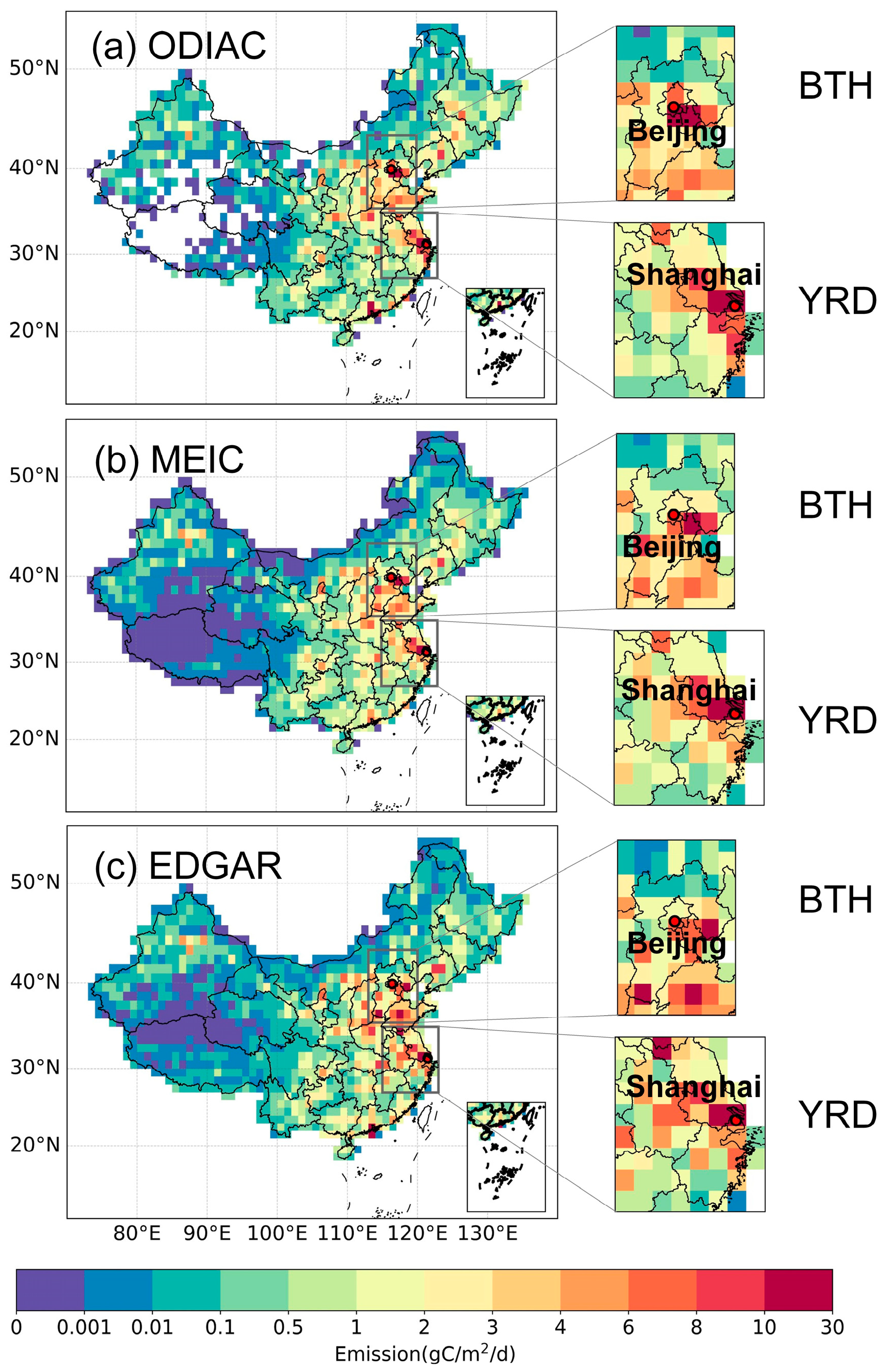

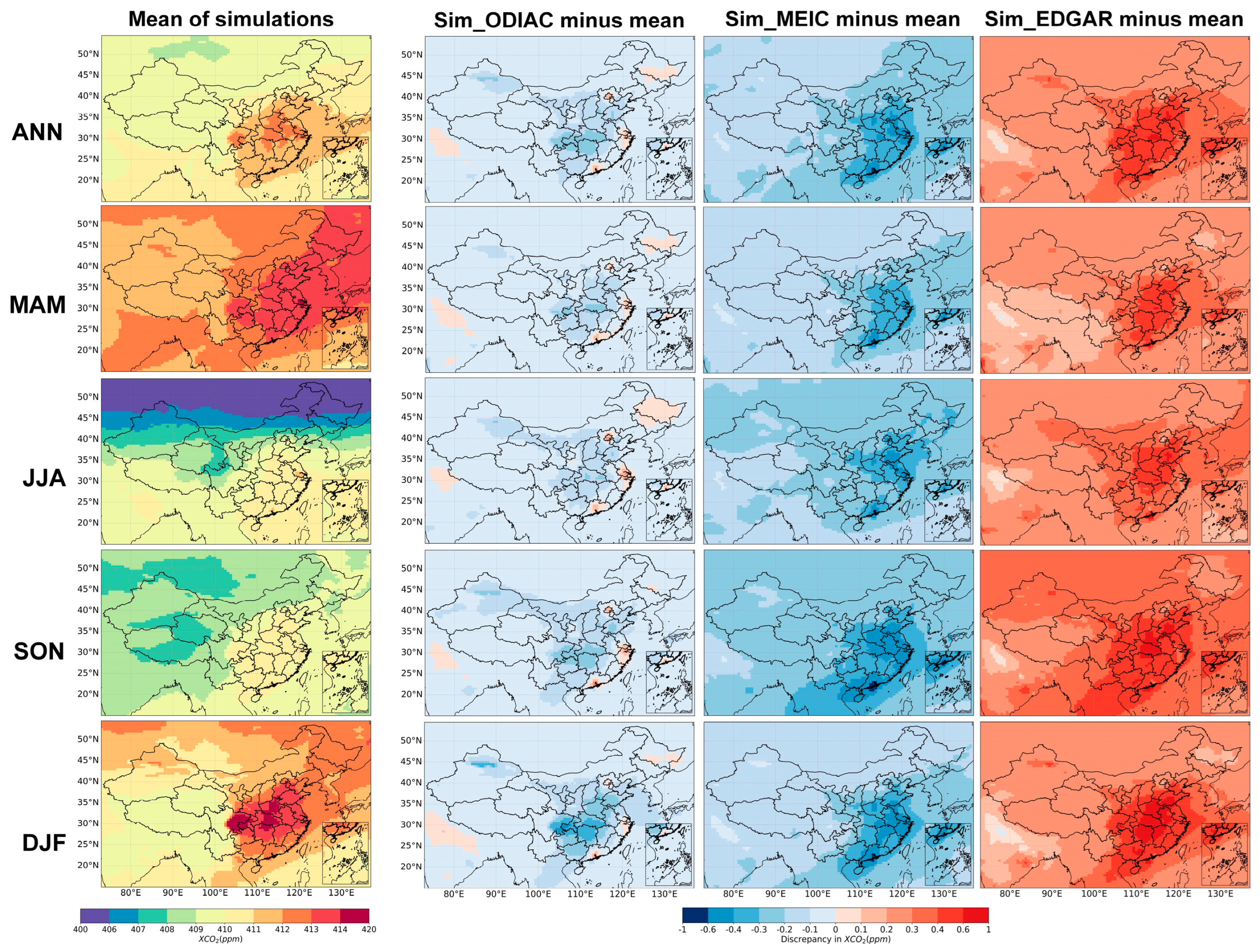

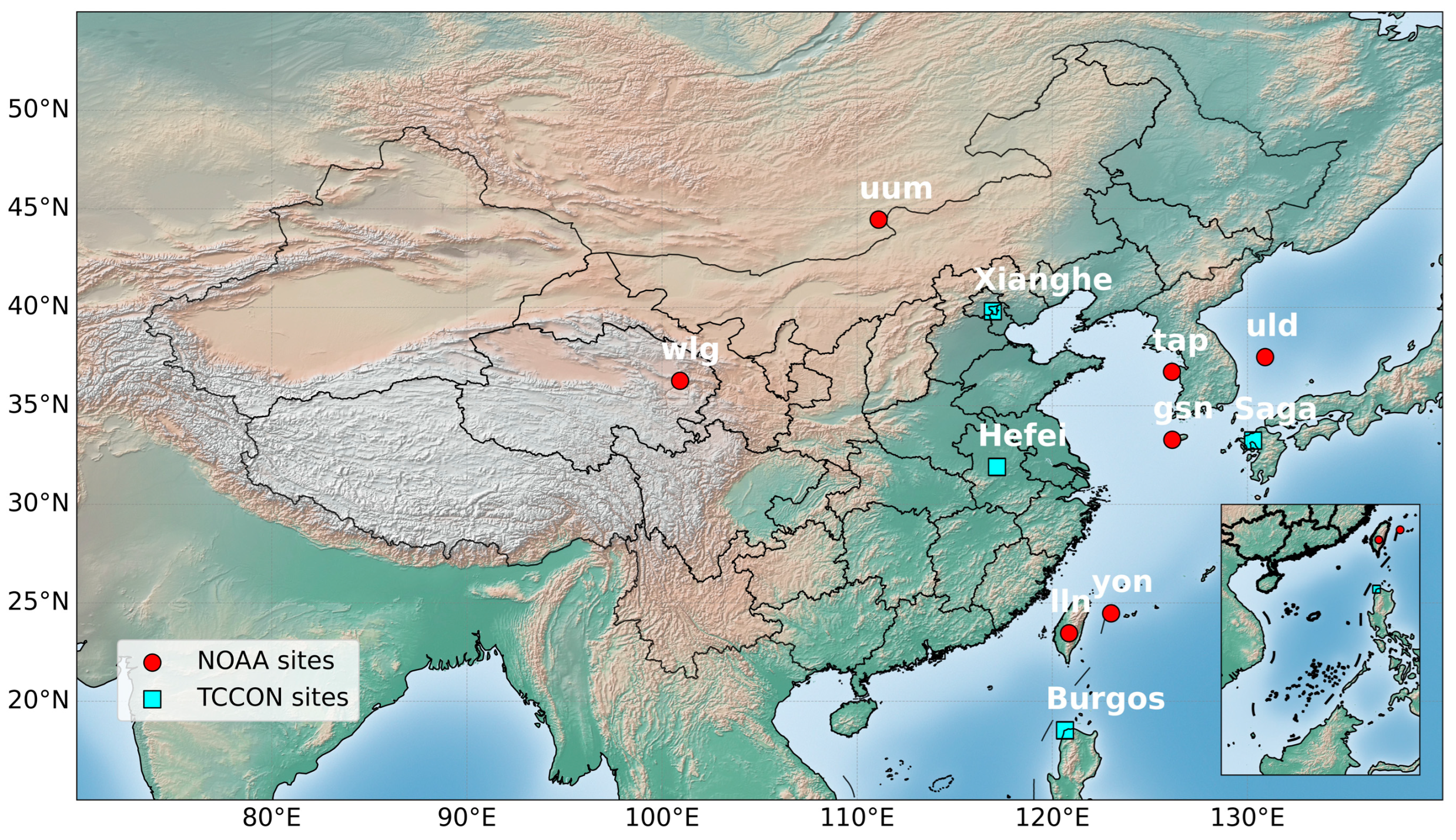
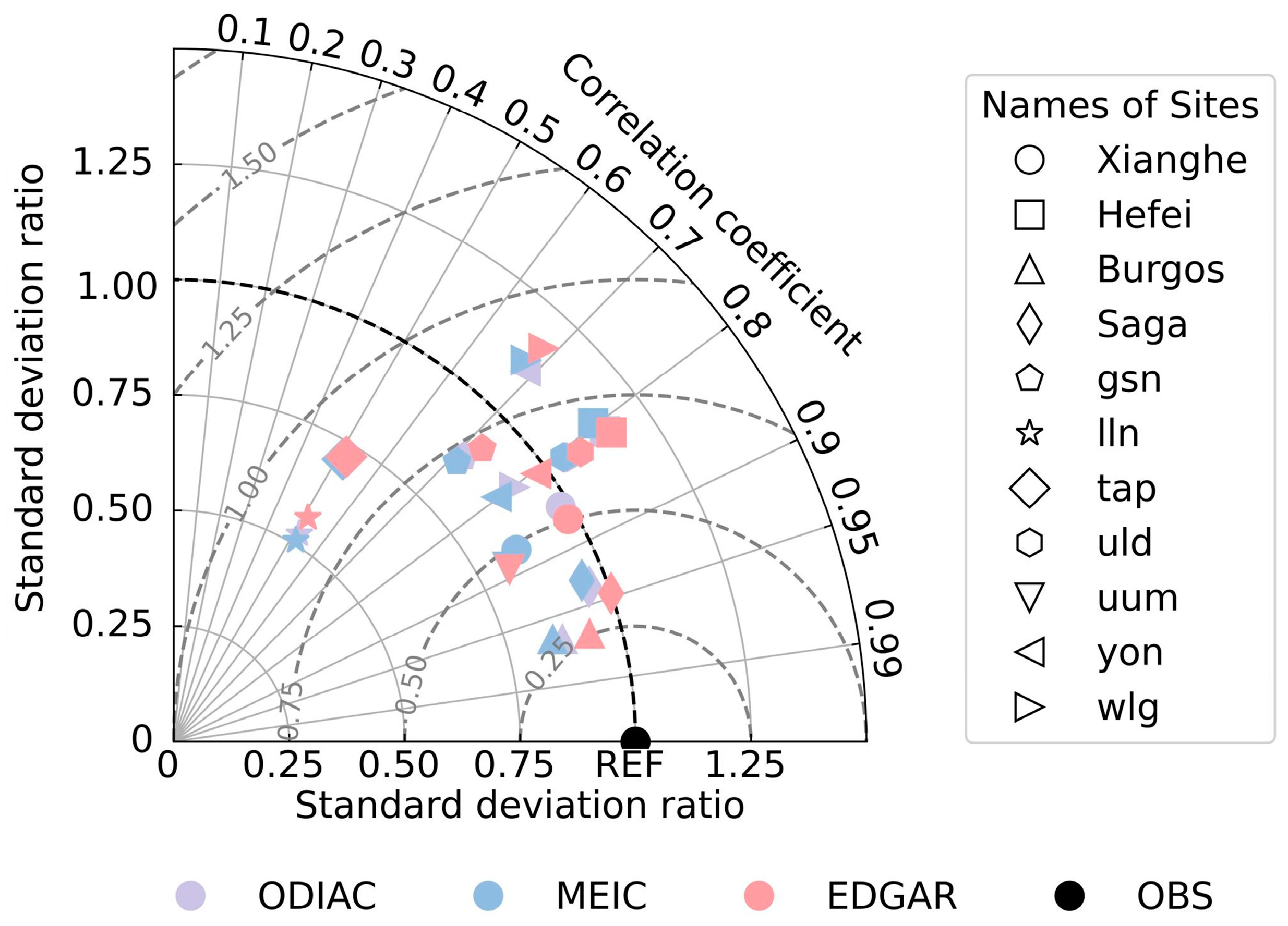
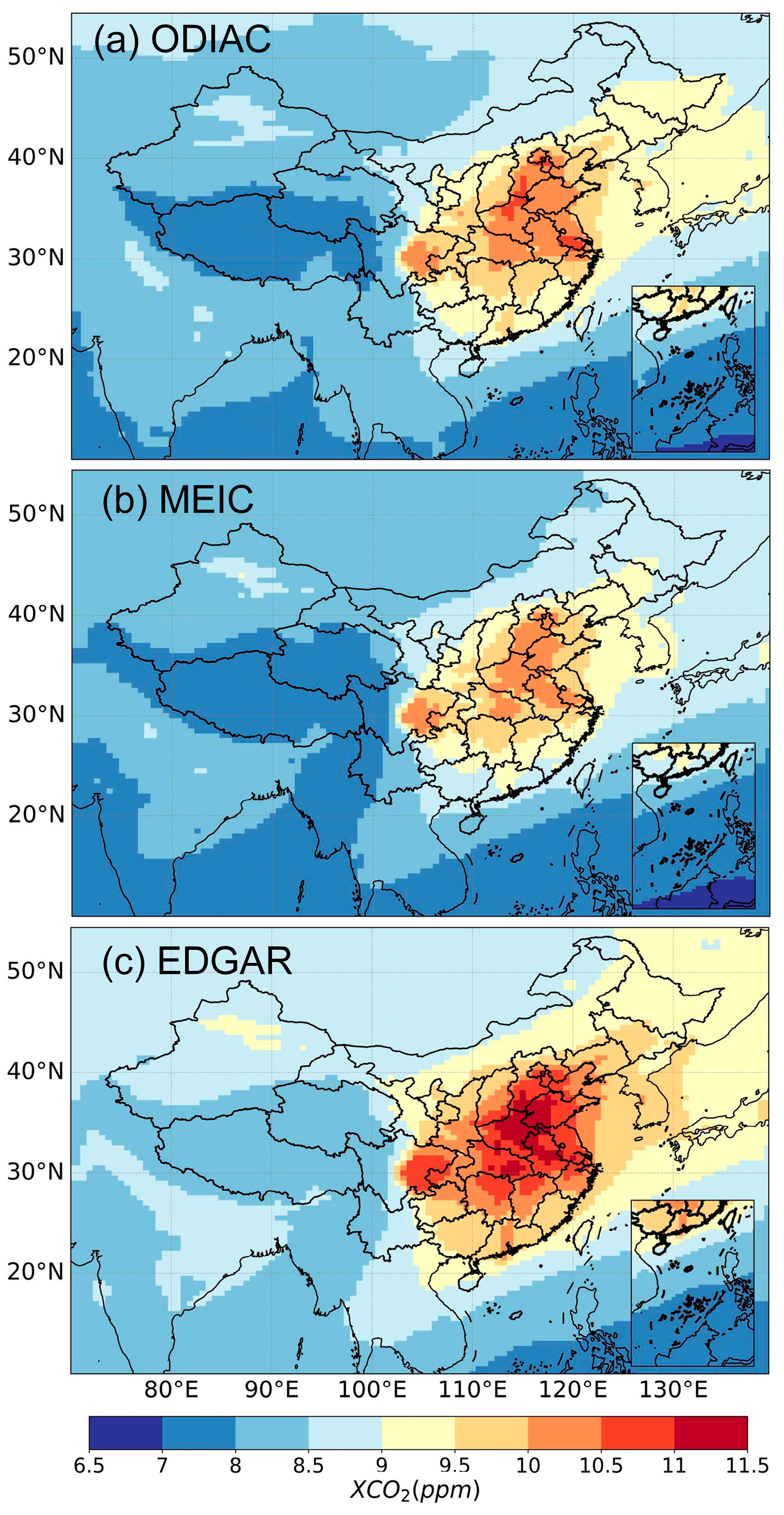
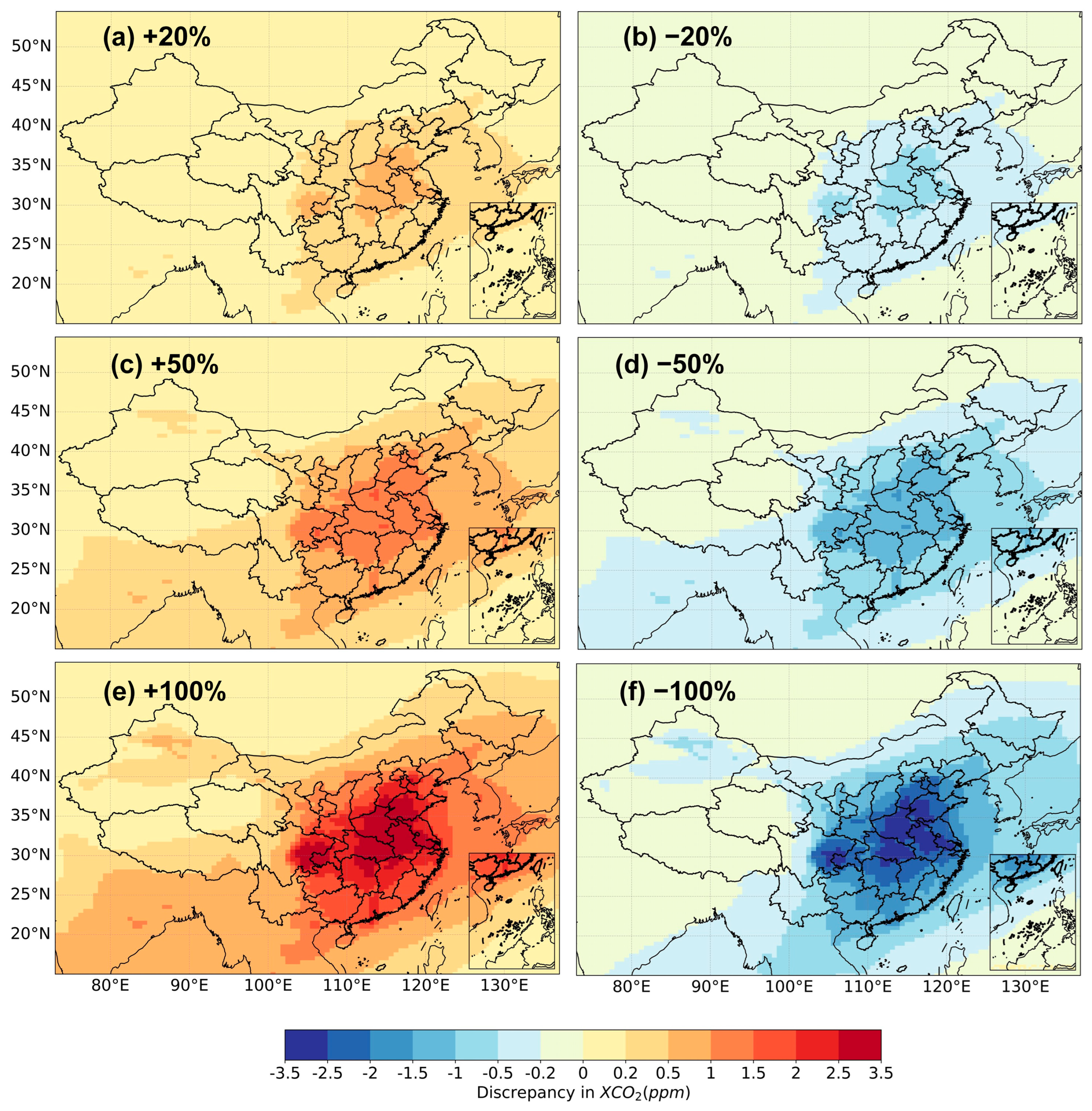
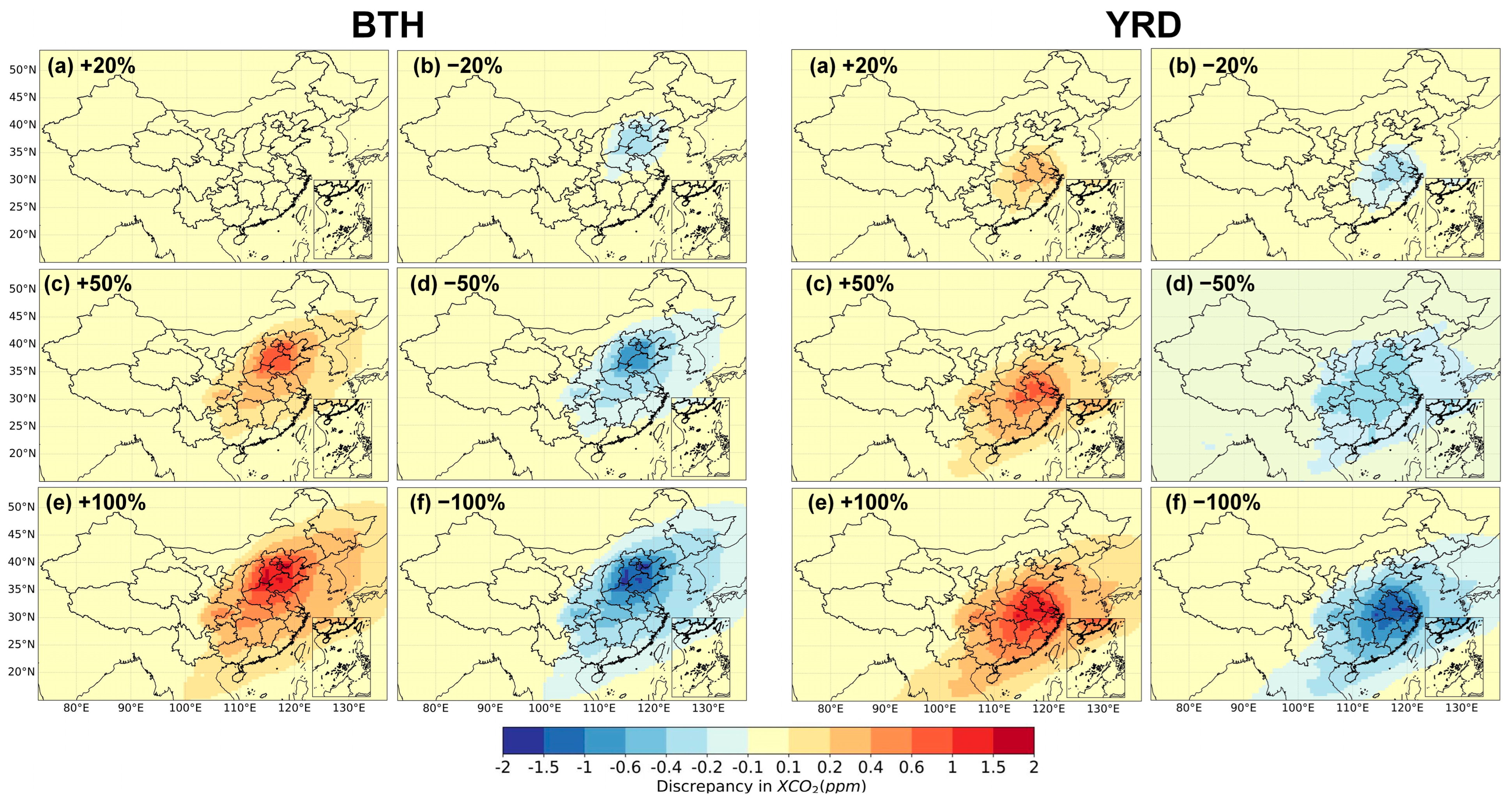
| Mean of XCO2 (ppm) | The Mean of Highest 10% XCO2 (ppm) | The Mean of Lowest 10% XCO2 (ppm) | Bias (ppm) | MAE (ppm) | RMSE (ppm) | Correlation Coefficient | ||
|---|---|---|---|---|---|---|---|---|
| MAM | Obs_OCO-2 | 414.50 | 417.51 | 411.51 | ||||
| Sim_ODIAC | 413.79 | 415.88 | 411.81 | 0.72 | 1.22 | 1.66 | 0.52 | |
| Sim_EDGAR | 414.26 | 416.39 | 412.24 | 0.24 | 1.09 | 1.51 | 0.52 | |
| Sim_MEIC | 413.61 | 415.67 | 411.65 | 0.89 | 1.30 | 1.74 | 0.52 | |
| JJA | Obs_OCO-2 | 410.73 | 415.40 | 404.80 | ||||
| Sim_ODIAC | 410.06 | 413.73 | 405.29 | 0.67 | 1.42 | 1.86 | 0.83 | |
| Sim_EDGAR | 410.59 | 414.26 | 405.82 | 0.14 | 1.29 | 1.74 | 0.83 | |
| Sim_MEIC | 409.84 | 413.54 | 405.01 | 0.88 | 1.51 | 1.93 | 0.83 | |
| SON | Obs_OCO-2 | 411.45 | 415.18 | 407.88 | ||||
| Sim_ODIAC | 410.32 | 412.68 | 407.97 | 1.13 | 1.54 | 1.99 | 0.60 | |
| Sim_EDGAR | 410.88 | 413.56 | 408.53 | 0.56 | 1.28 | 1.73 | 0.60 | |
| Sim_MEIC | 410.06 | 412.35 | 407.70 | 1.39 | 1.70 | 2.15 | 0.60 | |
| DJF | Obs_OCO-2 | 413.04 | 416.71 | 410.38 | ||||
| Sim_ODIAC | 412.32 | 414.86 | 410.38 | 0.72 | 1.36 | 1.82 | 0.53 | |
| Sim_EDGAR | 412.80 | 415.58 | 410.74 | 0.25 | 1.24 | 1.68 | 0.55 | |
| Sim_MEIC | 412.11 | 414.54 | 410.21 | 0.93 | 1.45 | 1.91 | 0.53 |
| Sites Name | Lat (°N) | Lon (°E) | Alt (m) | Emission Inventories | Std_r | Bias (ppm) | Correlation Coefficient |
|---|---|---|---|---|---|---|---|
| Xianghe | 39.80 | 116.96 | / | ODIAC | 0.98 | −0.063 | 0.855 |
| EDGAR | 0.98 | −0.150 | 0.871 | ||||
| MEIC | 0.95 | −0.577 | 0.873 | ||||
| Hefei | 31.90 | 117.17 | / | ODIAC | 1.15 | −0.555 | 0.812 |
| EDGAR | 1.16 | 0.063 | 0.817 | ||||
| MEIC | 1.14 | −0.605 | 0.7966 | ||||
| Burgos | 18.53 | 120.65 | / | ODIAC | 0.87 | −0.989 | 0.967 |
| EDGAR | 0.93 | −0.704 | 0.968 | ||||
| MEIC | 0.85 | −1.009 | 0.9656 | ||||
| Saga | 33.24 | 130.29 | / | ODIAC | 0.96 | −0.673 | 0.937 |
| EDGAR | 1.00 | −0.244 | 0.947 | ||||
| MEIC | 0.95 | −0.704 | 0.930 | ||||
| gsn | 33.28 | 126.15 | 78 | ODIAC | 0.880 | 2.209 | 0.713 |
| EDGAR | 0.921 | 1.498 | 0.725 | ||||
| MEIC | 0.862 | 2.604 | 0.711 | ||||
| lln | 23.46 | 120.86 | 2867 | ODIAC | 0.525 | 3.616 | 0.518 |
| EDGAR | 0.565 | 3.300 | 0.514 | ||||
| MEIC | 0.509 | 3.770 | 0.519 | ||||
| tap | 36.73 | 126.13 | 21 | ODIAC | 0.712 | 2.611 | 0.513 |
| EDGAR | 0.721 | 0.942 | 0.518 | ||||
| MEIC | 0.713 | 2.936 | 0.514 | ||||
| uld | 37.48 | 130.90 | 231 | ODIAC | 1.050 | 2.016 | 0.810 |
| EDGAR | 1.081 | 1.379 | 0.815 | ||||
| MEIC | 1.045 | 2.340 | 0.808 | ||||
| uum | 44.45 | 111.10 | 1012 | ODIAC | 0.816 | 2.188 | 0.886 |
| EDGAR | 0.815 | 1.802 | 0.890 | ||||
| MEIC | 0.816 | 2.330 | 0.886 | ||||
| yon | 24.47 | 123.01 | 50 | ODIAC | 1.106 | 0.984 | 0.801 |
| EDGAR | 0.976 | 0.379 | 0.804 | ||||
| MEIC | 0.877 | 1.268 | 0.797 | ||||
| wlg | 36.27 | 100.92 | 3815 | ODIAC | 0.920 | −2.461 | 0.689 |
| EDGAR | 1.169 | −3.194 | 0.685 | ||||
| MEIC | 1.124 | −2.423 | 0.678 |
Disclaimer/Publisher’s Note: The statements, opinions and data contained in all publications are solely those of the individual author(s) and contributor(s) and not of MDPI and/or the editor(s). MDPI and/or the editor(s) disclaim responsibility for any injury to people or property resulting from any ideas, methods, instructions or products referred to in the content. |
© 2025 by the authors. Licensee MDPI, Basel, Switzerland. This article is an open access article distributed under the terms and conditions of the Creative Commons Attribution (CC BY) license (https://creativecommons.org/licenses/by/4.0/).
Share and Cite
Lu, W.; Li, X.; Li, S.; Cheng, T.; Guo, Y.; Fang, W. Effects of Emission Variability on Atmospheric CO2 Concentrations in Mainland China. Remote Sens. 2025, 17, 814. https://doi.org/10.3390/rs17050814
Lu W, Li X, Li S, Cheng T, Guo Y, Fang W. Effects of Emission Variability on Atmospheric CO2 Concentrations in Mainland China. Remote Sensing. 2025; 17(5):814. https://doi.org/10.3390/rs17050814
Chicago/Turabian StyleLu, Wenjing, Xiaoying Li, Shenshen Li, Tianhai Cheng, Yuhang Guo, and Weifang Fang. 2025. "Effects of Emission Variability on Atmospheric CO2 Concentrations in Mainland China" Remote Sensing 17, no. 5: 814. https://doi.org/10.3390/rs17050814
APA StyleLu, W., Li, X., Li, S., Cheng, T., Guo, Y., & Fang, W. (2025). Effects of Emission Variability on Atmospheric CO2 Concentrations in Mainland China. Remote Sensing, 17(5), 814. https://doi.org/10.3390/rs17050814






